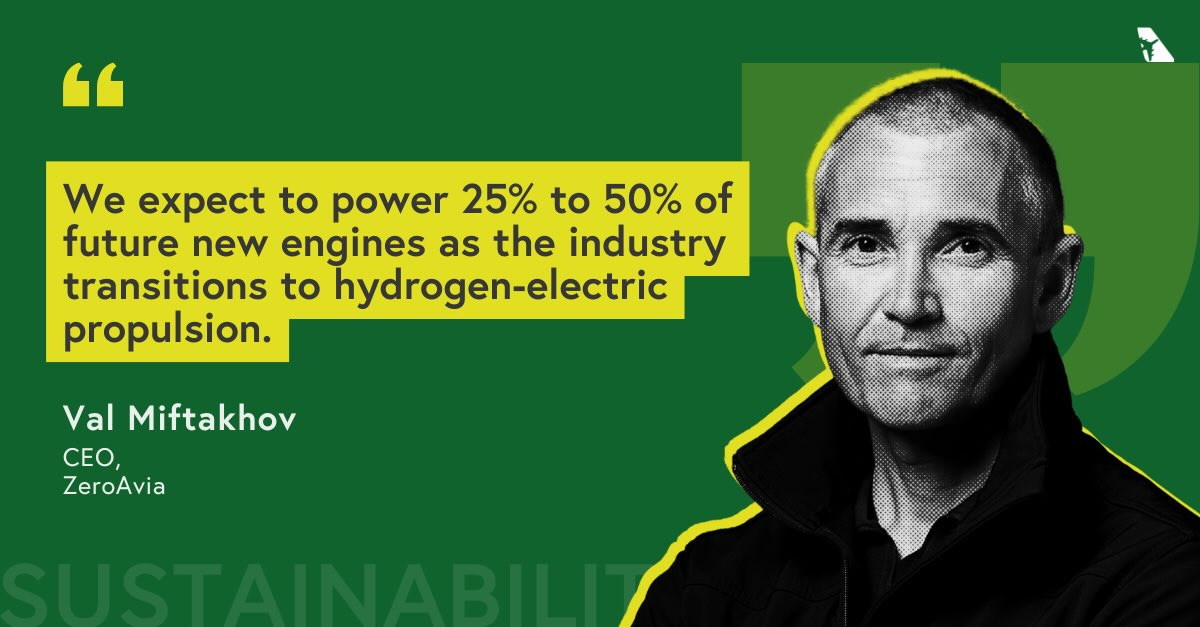In this episode of our ‘Sustainability in the Air’ podcast, Val Miftakhov, founder and CEO of ZeroAvia, speaks with SimpliFlying’s CEO Shashank Nigam about how the company is developing hydrogen-electric propulsion systems that promise to transform commercial aviation this decade.
Drawing from his background in electric vehicle infrastructure, Miftakhov is pushing for a wholesale transition away from fossil fuels in aviation, with the potential to power 25% to 50% of future new engines.
When Miftakhov last appeared on our podcast in 2022, ZeroAvia had just completed early flight tests with their Dornier 228 aircraft and was focused on developing 10-20 seat commercial aircraft with 500-mile range through retrofitting existing airframes. Since that conversation, ZeroAvia has won major commercial orders, achieved regulatory approval milestones, and established global manufacturing facilities.
Here are the key highlights of the conversation:
Recognition and manufacturing expansion (1:40)
ZeroAvia’s global manufacturing strategy: Seattle, Kemble, and Glasgow (3:30)
Vertical integration vs external suppliers (10:00)
Geographic distribution and geopolitical hedging (13:03)
Commercial traction and certification progress (19:20)
Hydrogen storage: gaseous vs liquid approaches (33:00)
Infrastructure partnerships and green hydrogen economics (39:30)
Certification milestones and regulatory progress (28:00)
Climate impact and contrail management (45:20)
The future of sustainable aviation fuels (52:00)
Keep reading for a detailed overview of the episode.
Why hydrogen-electric propulsion matters
Hydrogen-electric propulsion offers a distinct alternative to both conventional jet engines and battery-electric aviation. ZeroAvia uses fuel cells to convert hydrogen into electricity, which then powers electric motors.
By avoiding combustion, the technology has the potential to significantly reduce emissions while also lowering maintenance requirements, since hydrogen-electric powertrains generally involve fewer moving parts than turbine engines.
Alternatives like battery-electric aircraft have been constrained by slower-than-expected improvements in energy density, limiting their use beyond small, short-range aircraft. Hydrogen, in contrast, provides a much higher energy-to-weight ratio, which is critical for scaling zero-emission flight to regional and larger aircraft, explains Miftakhov.
Moreover, hydrogen also offers significant efficiency advantages compared to sustainable aviation fuel (SAF). While SAF can reduce lifecycle emissions, it requires complex production processes that consume significant amounts of renewable energy. In contrast, green hydrogen can be generated directly through electrolysis powered by renewable electricity, creating a potentially more scalable and cost-effective way to decarbonise aviation, says Miftakhov.
The company’s strategy reflects a broader view that aviation cannot meet net-zero goals by substituting fuels alone. Achieving meaningful progress will likely require new propulsion architectures that combine environmental benefits with economic viability. ZeroAvia sees hydrogen-electric powertrains as a credible step in that direction.
Four ways ZeroAvia is reshaping sustainable aviation
1. Strategic vertical integration
ZeroAvia has pursued a deliberate strategy of vertical integration, keeping the development of its core technologies in-house rather than relying heavily on external vendors.
The company designs and develops its own fuel cells, power electronics, and electric motors, ensuring that the most critical components of its powertrain remain under direct control.
This contrasts with competitors in hydrogen aviation, who have relied on third-party suppliers that often have roots in the automotive sector. According to Miftakhov, that dependency has created vulnerabilities because automotive technologies and business models do not always translate well into aerospace. Moreover, suppliers may prioritise other markets or shift direction, leaving aviation programs exposed.
One example he points to is Universal Hydrogen, which faced setbacks when its supplier, magniX, did not pursue development of a larger motor, causing significant disruption to Universal’s programme. Similar risks, Miftakhov argues, can affect any company that outsources key parts of the technology stack.
ZeroAvia maintains ownership of its intellectual property and outsources only commoditised components, using suppliers mainly for manufacturing rather than design. This approach provides control over technical specifications, protects program timelines, and aligns with strategies seen at successful aerospace innovators such as Joby and Archer, says Miftakhov.
2. Geographic diversification as a competitive advantage
ZeroAvia’s global expansion is deliberately structured to balance technical focus and manufacturing scalability.
The company has established Centres of Excellence designed to co-locate R&D with early-stage manufacturing, ensuring that product introduction stays tightly linked with engineering teams. This model helps accelerate iteration, smooth the transition from design to production, and reduce time-to-market for new technologies.
In the United States, ZeroAvia consolidated its team into a 150,000-square-foot facility in Everett, Washington, formerly operated by Collins Aerospace. Now designated as the Center of Excellence for Electric Propulsion, the site houses around 100 employees developing the company’s in-house motors, power electronics, and propulsion systems.
ZeroAvia is also replicating the model in Glasgow, Scotland, with a new Center of Excellence for hydrogen fuel cells. The location was chosen after a review of more than a dozen potential sites across the UK, with Glasgow offering a unique combination of factors: proximity to Glasgow Airport, an available skilled manufacturing workforce, and robust renewable energy infrastructure, including over 20 megawatts of on-site power and plans for hydrogen production.
Government support has further strengthened the company’s UK presence. ZeroAvia has received significant backing from the Aerospace Technology Institute, the UK Infrastructure Bank, and the Scottish National Investment Bank, reinforcing its role in the country’s clean aviation ecosystem.
3. Regulatory progress and certification
ZeroAvia has reached significant regulatory milestones, beginning with the FAA G-1 Issue Paper for its 600kW electric propulsion system earlier this year. Miftakhov explains that the certification process broadly involves three major stages: the certification basis agreement (G1), the means of compliance (G2), and final certification.
The G1 step is especially significant because no hydrogen-electric engine has ever been certified before. Unlike manufacturers such as Rolls-Royce or Pratt & Whitney, who work with an existing “rulebook” to craft their engines, ZeroAvia has had to create the rules in collaboration with regulators. The published G1 establishes which rules apply, how they apply, and what new provisions are required for hydrogen-electric propulsion.
Building on this foundation, recently ZeroAvia also secured a P-1 Special Conditions Issue Paper from the FAA, which documents the additional requirements specific to its 600kW electric propulsion system.
The company is now advancing toward the G2 milestone, which sets out exactly how compliance with the certification rules will be demonstrated. This includes the specific ground and flight tests, simulations, and performance outcomes needed to substantiate the certification basis. ZeroAvia has already submitted a proposal to the FAA and has begun low-risk testing in anticipation of formal agreement.
4. Addressing the non-CO2 effects
ZeroAvia’s approach extends beyond simple carbon reduction to address broader sustainability challenges, including noise, nitrogen oxides (NOx), and contrail formation. The company has also developed intellectual property around managing water vapour emissions to eliminate contrails, a significant advantage over combustion engines.
“With the fuel cells, you produce the water vapour at low temperature that can be actually managed,” Miftakhov explains. “We have actually a good volume of IP around this, with the idea to condense the water vapour coming out of the engine at high altitudes and release it in, let's say, ice form at altitude.”
With 3,000 engines on order worth $10 billion and major investors including Airbus, ZeroAvia has demonstrated that hydrogen-electric aviation represents not just environmental progress, but a commercially viable path to aviation’s sustainable future.
Get our new book
Our new book Sustainability in the Air: Volume Two is now available for purchase on Amazon. Learn more about the startups, strategists, and sceptics working to close the gap between growth and green ambition.
‘Sustainability in the Air’ is the world’s leading podcast dedicated to sustainable aviation. Through in-depth conversations with top aviation leaders, we break through the clutter and provide a clear roadmap for a net-zero future.













